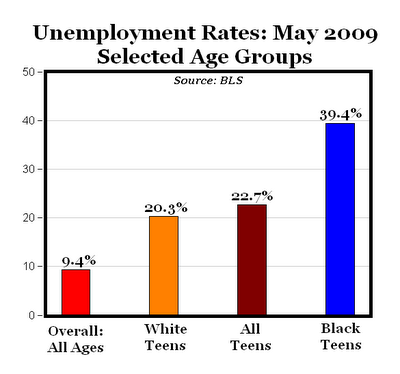Next month, the minimum wage in America is going to raise from $6.55 an hour to $7.25 an hour. The $6.55 to $7.25 jump is the last of the increases to the minimum wage under the Fair Minimum Wage Act of 2007. The minimum wage is a sexy law; politicians can stand hand in hand with the lowest income workers and say, "I'm fighting for you!". Unfortunately, the low income workers are holding the hands that hold them down.
Who Loses Here?
Unemployment is continuing its steady march towards levels unseen in a generation. The headline number, a U-3 of 9.4% for May, signals double digit unemployment is not far away. However, 9.4% doesn't seem too bad when viewed in comparison to two other numbers:
22.7% - The Unemployment Rate for Teens
15.5% - The Unemployment Rate for Workers Without a High School Diploma
(source: BLS May 2009 Employment Release)
Quite simply, the people who will be most affected by the upcoming minimum wage hike are hurting the most in the current economy. Is now the best time to be increasing the minimum wage? David Neumark doesn't think so in this piece which recently appeared in the Wall Street Journal. The following chart, from the Bureau of Labor Statistics, illustrates how bad it is already...

Bureau of Labor Statistics Graph of Teen Unemployment
Supply and Demand
Simply put, the fact that there is a Minimum Wage law means that there is demand for people to fill these jobs. Currently, people fitting the category of minimum wage workers cost $6.55 an hour in order to utilize. An increase in the minimum wage of almost 11% will decrease the number of positions for these workers. The standard economic illustration of the effect of the minimum wage on employment is detailed in this informative Wikipedia entry:

Wikipedia Supply and Demand Illustration
Demand is shown as shrinking as wages increase, while the supply of labor (in hours) is plotted as increasing. The equilibrium point is the point at which the wage rates would be set in the absence of a minimum wage law- the number of hours supplied by the labor market meets the demand from employers. The minimum wage sets an artificial floor where people are willing to work for less and there is work available. The shaded triangle signifies unmet demand on the employer side, and unemployment (and its cousin, under-utilization) on the employee side.
Milton Friedman and the Minimum Wage
Milton Friedman, all around smart guy and Nobel prize winner, agrees. Milton devoted much thought to the idea of minimum wage and its effect on uneducated and younger workers (those most likely to take minimum wage jobs). Here's a clip of Milton Friedman explaining this effect. (transcript)
Milton Friedman talks with Richard D. Heffner
Milton isn't alone... Greg Mankiw, David Neumark, James Buchanan, and many others have come out against the Minimum Wage law. In fact, opposition to the law doesn't come from a small subset of economists. Reducing, eliminating, or keeping the minimum wage static is supported by a majority of economists (shown in this 2006 Robert Whaples Study, "Do Economists Agree on Anything? Yes!").
Still think it's a good idea?
The Future of the Law
The Minimum Wage Law, now in the books, has a lot of political backing. It is a law passed with the absolute best of intentions, but without enough thought as to the desired results. The minimum wage law limits unemployment of workers at the margin, and hurts businesses that employ minimum wage workers. The goal of the Minimum Wage Law is to improve the living conditions of the lowest earning employees. Unfortuneately, the very workers it desires to help are being hurt by the unintended effects.
The entrenchment of the law is possibly attributable to a lack of economic education by the average American. Possibly, as Friedman suggests, it is due to special interests aligning behind the law for their own benefit. Regardless, the law isn't going to be repealed anytime soon. The only reasonable course is to look at alternatives to the law which could be substituted in the future. (Hopefully while leaving the minimum wage law static.)
Possible Alternative
As with anything which mandates changes to the laws in America, you have to first agree that something should be done before looking at things that could. If you agree that fixing this situation is a valuable undertaking, consider the following possibility. Support for lower income taxpayers could better come from a refund of income tax. Both the Congressional Budget Office and Greg Mankiw have writings on this very subject. The EITC, Earned Income Tax Credit, is a refundable tax credit targeting the same demographic as the Minimum Wage purports to help.
Another alternative is the "Basic Income", the idea that the government could pay the entirety of the United States some sustainable amount of income. Many economists have come out in favor of this idea. It would put a floor on the amount taken home by individuals. A web site detailing this movement can be found here.
Alternatively, the Minimum Wage could be repealed. Similar to this idea, inflation could also be used to negate the negative effect of the law. Inflation could erode the value of $7.25 an hour to a point where utilization at the lower end of the labor market would increase.
In my opinion, the law is incorrect. 'Minimum Wages' (and Maximum Wages) are not something the government should be involved in setting. Repealing the law would be the best first step to increasing the utilization of the teenage and lower educated workers who have the highest rates of unemployment. Letting inflation slowly undo the effect of the law seems disingenuous, but would acheive the same basic effect eventually.
In this case, perhaps doing nothing is the best thing our government can do.
